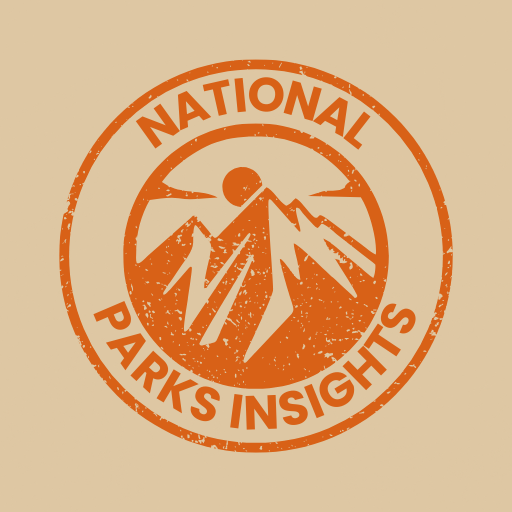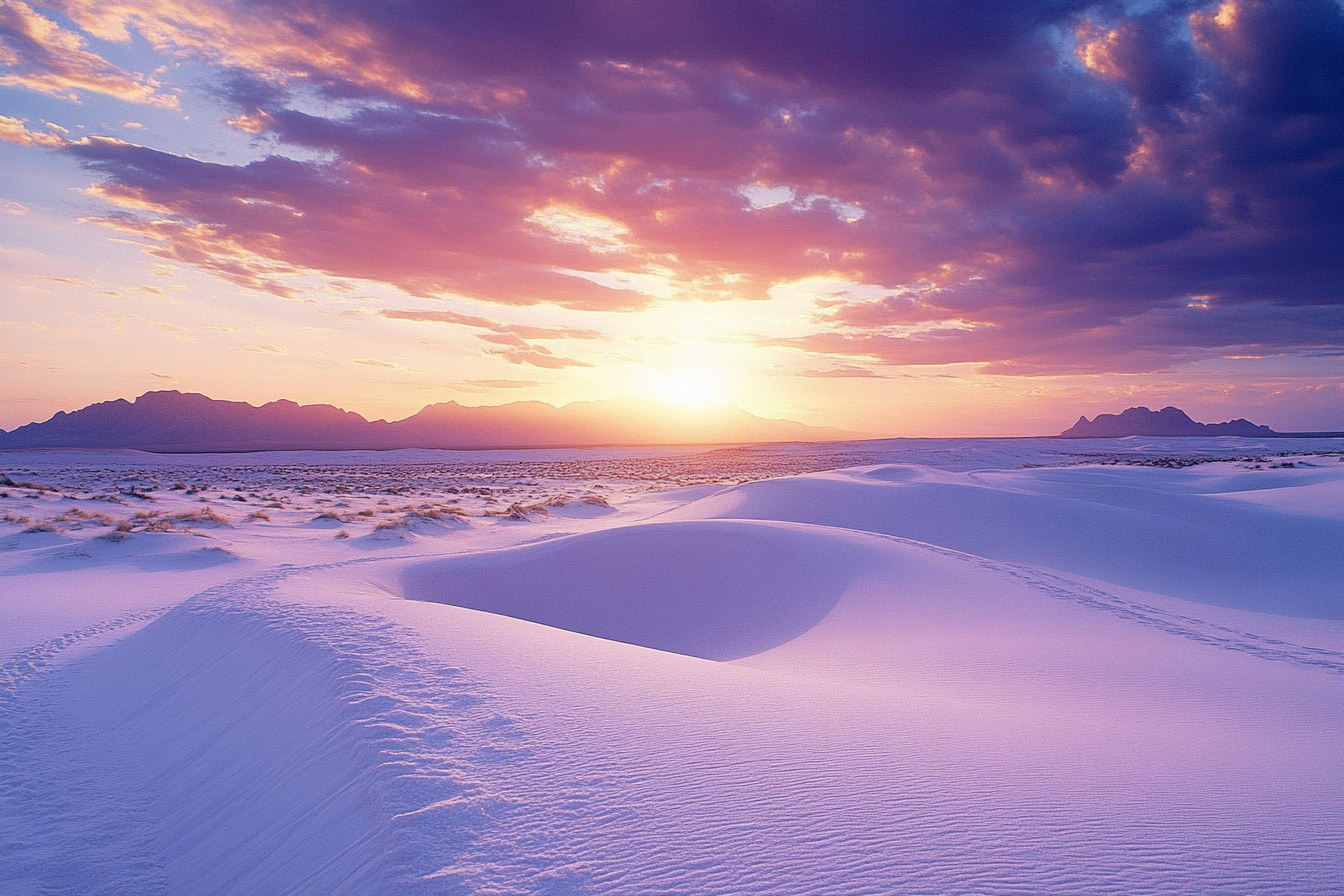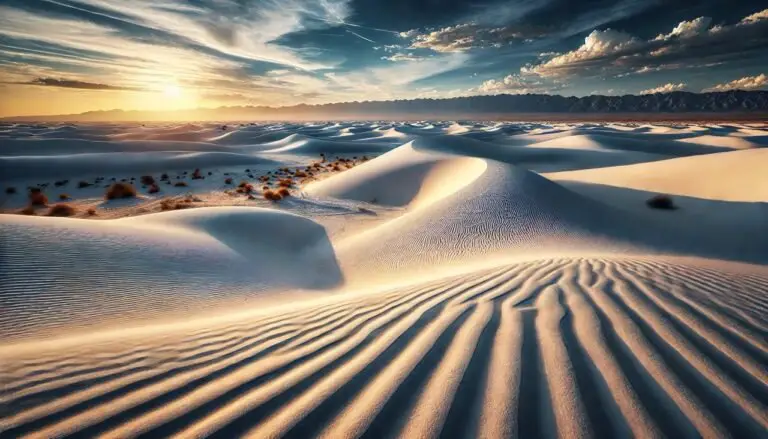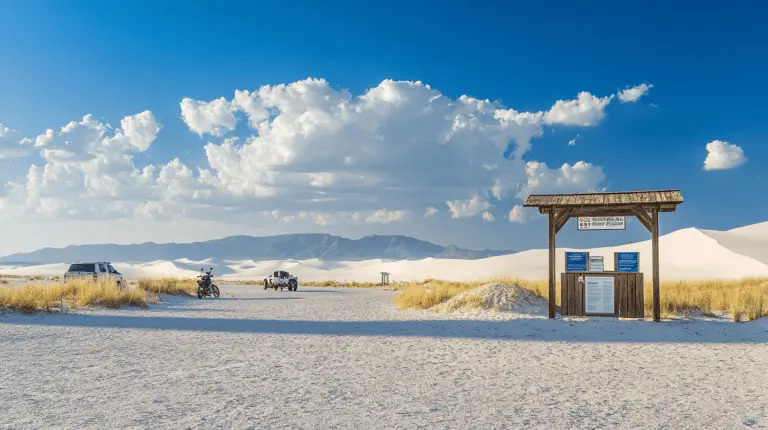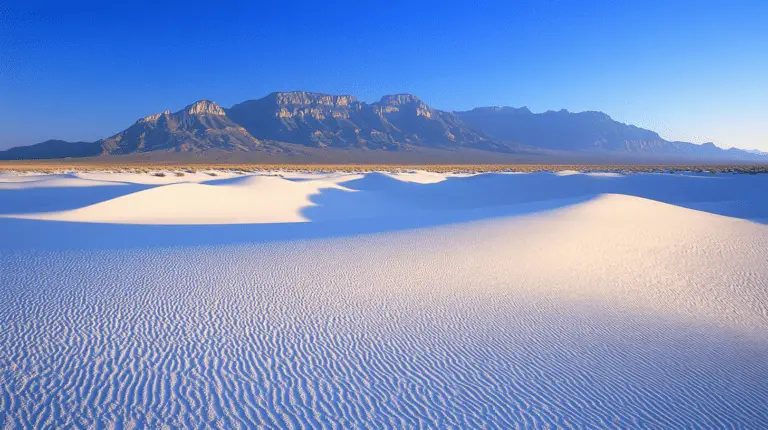Why White Sands NP Is a Must-Visit
Thinking about visiting White Sands National Park? Don’t worry, we’ve got the lowdown to make sure your trip is smooth sailing. Here’s what you need to know – from getting there to the ins and outs of the visitor center.
Getting There
White Sands National Park sits in the lap of Holloman Air Force Base, NM. To make it easy, here’s the address you might need for your GPS:
PO Box 1086,
Holloman AFB, NM 88330
Directions from National Park Service
Here are some common routes to get you there:
| Starting From | Directions |
|---|---|
| Alamogordo, NM | Cruise on US-70 W for about 15 miles |
| Las Cruces, NM | Take US-70 E, travel for around 52 miles |
Need a better idea of your route? Check out our detailed map.
Visitor Center Details
The White Sands Visitor Center is your go-to spot for all you need to know during your visit. It’s open almost all year round, closing only on Thanksgiving and Christmas. Make sure to check the current hours before heading out:
| Facility | Hours |
|---|---|
| Visitor Center | Opens at 9:00 am, closing time varies with the season |
| White Sands Trading Post | Same opening time, closing varies too |
Need facilities? Main restrooms are right next to the visitor center. Extra toilets (vault style) are set up along Dunes Drive. Check out how we keep our restrooms clean.
White Sands Trading Post
Right next to the visitor center’s courtyard, you’ll find the Trading Post Gift Shop. From snacks to mementos, and sleds for the dunes (sleds info), it’s got you covered. Open same days as the visitor center.
Must-Watch Park Film
While you’re getting your bearings at the visitor center, make sure to catch the 17-minute park film. It runs every 30 minutes starting from 9:00 am until half an hour before closing. There’s even a Spanish version and audio descriptions if you need them (National Park Service).
For further details on the visitor center and related amenities, don’t forget to swing by our page on White Sands Visitor Center.
Your adventure awaits – get ready to explore!
Rules and Regulations
When hanging out at White Sands National Park, it’s crucial to follow the rules to keep everyone safe and have a good time. This section covers how to protect the park’s resources, manage alcohol, and handle pets.
Protect the Park
White Sands National Park is loaded with unique sand dunes and fragile wildlife. You’re not allowed to take anything out of the park—not even a pinch of that cool gypsum sand! Messing with plants or cultural objects? Big no-no. Break these rules, and you might face a $5,000 fine or even spend up to six months in the slammer (National Park Service – White Sands NP).
| Offense | Penalty |
|---|---|
| Taking stuff from the park | $5,000 fine or 6 months in jail |
Want to get more info on how you can help keep the park pretty? Visit our page on white sands national park regulations.
Alcohol Rules
Alcohol rules at White Sands are there to keep things safe. From February 1st to May 31st, no booze anywhere in the park. The rest of the year, you can only have alcohol in certain picnic spots and during park events (National Park Service – White Sands NP).
| Time Period | Alcohol Allowance |
|---|---|
| Feb 1 – May 31 | No alcohol allowed |
| Jun 1 – Jan 31 | Only in specific areas/events |
Before you head over, check out white sands national park hours to make sure you’re following the rules.
Pet Policies
Bringing your furry friend? Cool, but there are some rules. Pets can hang in the park but not in the visitor center or gift shop. Unless they’re service animals, leave them out. Also, don’t leave them in the car and be a good owner—clean up after them using the provided pet waste stations (National Park Service).
| Policy | Description |
|---|---|
| Pet Areas | Pets welcome in the park, not inside the visitor center/gift shop |
| Clean-Up | Use pet waste stations |
| Unattended Pets | Don’t leave pets in the car |
For a full rundown on pet rules, check out our pet-friendly guidelines.
By following these tips, you’ll be helping to protect White Sands and making sure everyone has a great visit. Want more insights? Read our articles on white sands national park plants and white sands national park hiking trails.
Explor-ing the Flora
Digging into the greenery of White Sands National Park shows us how tough and beautiful plants can be, even when life gives them a tough hand. These are plants that have figured out how to survive some pretty harsh surroundings.
Plant Superpowers
Living—and thriving—in the White Sands National Park isn’t for the faint of heart. Plants have to deal with soil that’s less than ideal and temperatures that go from freezing all the way up to sweltering hot (National Park Service). These plants have a few tricks up their sleeves:
- Water Hoarding: Some plants store water in their leaves or stems to make it through dry spells.
- Going Deep: Roots either dig deep or spread out wide to grab any water they can find.
- Tiny or No Leaves: This trick helps cut down on water escaping through evaporation.
Succulent Survivors
Desert succulents, like cacti, are the rock stars of the plant world here. They don’t need much water and can handle the heat. Plus, they put on a gorgeous flower show every spring (National Park Service). Here are a few of the top performers:
| Plant Type | Cool Tricks | Best Features |
|---|---|---|
| Cacti | Water-storing stems | Spiky armor for protection |
| Agave | Keeps stomata closed by day | Thick, fleshy leaves arranged in a rosette |
| Yucca | Super deep roots | Tall, dramatic flower spikes |
Check out more plant life at White Sands National Park to see these tough customers in action.
Grass Heroes
Desert grasses are like the underdogs of this park. Types like alkali sacaton and Indian rice grass are pros at living in alkaline soil. These grasses stabilize the ground and feed a bunch of small critters (National Park Service).
| Grass Type | Survival Skill | Importance |
|---|---|---|
| Alkali Sacaton | Loves alkaline soils | Helps keep the soil in place |
| Indian Rice Grass | Deep roots for water | Seeds are a snack for rodents |
Taking time to learn about these amazing plant adaptations gives you a whole new level of respect for the park’s ecosystem. Next time you’re hiking the White Sands trails or stopping by the visitor center, keep an eye out for these incredible plants. They’re nature’s way of showing us what resilience really looks like.
Visitor Facilities
White Sands Trading Post
Right next to the White Sands National Park Visitor Center, the White Sands Trading Post is a treasure trove for tourists. Open almost every day of the year (National Park Service), it sells everything from keepsakes to water and snacks. If sledding down the sparkling white dunes is on your bucket list, this is your go-to place to pick up or rent sleds.
| Item | Availability |
|---|---|
| Souvenirs | Year-Round |
| Bottled Water | Year-Round |
| Pre-Packaged Food | Year-Round |
| Sleds | Year-Round |
Got sledding on your mind? Check out our detailed guide on white sands national park sleds.
The Park Film
Starting your visit with the park film is a fantastic idea. Running for just 17 minutes, the film shows every half-hour starting at 9:00 am until half an hour before the visitor center closes (National Park Service). It’s a quick crash course on the park’s history, cool geological stuff, and its quirky plants and animals. Spanish and audio description versions are also available if you ask.
| Showtimes | Film Duration |
|---|---|
| Every 30 Minutes | 17 Minutes |
Want to plan better? Check out the visitor center hours at white sands national park hours.
Historic Visitor Center
Built between 1936 and 1940, the Historic Visitor Center is the heart of White Sands National Park. It’s been a part of the White Sands National Park Historic District since 1990 (National Park Service), showcasing awesome architecture put together by WPA workers. The center not only shares valuable info and has cool exhibits, but it’s also the perfect place to start your deep dive into the park’s amazing history.
| Year Built | Designation Year |
|---|---|
| 1936 – 1940 | 1990 |
Hungry for more history and rock facts? Visit our pages on white sands national park history and white sands national park geology.
Geological Formation
Check out the geological magic of White Sands National Park—it’s a real treat! The park’s one-of-a-kind scenery paints a vivid picture of earth’s movements, natural processes, and the massive gypsum dunefield you’re standing on.
Formation Process
About 2 to 3 million years ago (give or take), the mighty Rio Grande was busy carrying sediment and minerals downstream, eventually dumping them into the Tularosa Basin. This led to the creation of giant Lake Otero, covering a whopping 1,600 square miles. Things changed around 11,000 years ago when the climate got warmer and Lake Otero started drying up, leaving behind the dry lake bed or “playa” we see today.
| Time (Years Ago) | What Happened? |
|---|---|
| 24,000 – 12,000 | Gypsum piled up during the Ice Age |
| 11,000 | Lake Otero dried up, becoming a playa |
| 10,000 – Now | Wind and sun turned this place into the Chihuahuan Desert |
Tectonic Movements
A lot of the park’s unique look comes from tectonic jerks and twitches. About 30 million years ago, tectonic plates got active, stretching and thinning the Earth’s crust here, forming the Tularosa Basin. This ongoing action caused the basin to sink and blocked it off from the sea, setting the stage for Lake Otero.
Gypsum Dunefield
Spanning 145,762 acres in the Tularosa Basin, White Sands National Park is home to the globe’s largest gypsum dunefield. It covers 41% of a 275-square-mile area filled with these glittering white gypsum crystals. These dunes can tower up to 60 feet and hold around 4.5 billion short tons of gypsum sand (Wikipedia).
| Gypsum Dunefield Fun Facts | Number |
|---|---|
| Area (acres) | 145,762 |
| Max Height (feet) | Up to 60 |
| Total Gypsum Sand | ~4.5 billion short tons |
Knowing these cool geological facts makes a visit to White Sands even more amazing. Swing by the White Sands Trading Post to soak up more info, and don’t miss our guide on white sands national park hours to help you plan your visit.
Want more hidden gems about the park’s features, history, and local plant life? Explore our articles on white sands national park history and white sands national park plants.
Historical Insights
White Sands National Park (WSNP) is like stepping into a time machine. This place has stories that span thousands of years, from ancient human activity to military milestones. Let’s take a fascinating trip through history to appreciate the wonders of this incredible spot.
Native American Presence
Long before it was a park, early Native American Paleo-Indians called the area around White Sands home. Imagine them living by what used to be Lake Otero, making tools from local stones to hunt mammoths, camels, ground sloths, and bison. These folks weren’t just hunters; they were farmers too, showing their skills way back during the Archaic period. They were like the early “MacGyvers” of their time, using whatever they could find to survive and thrive.
Jump forward a few centuries, and you see bands of Apaches moving in, following bison herds from the Great Plains. The Apache Wars with American settlers eventually pushed them to the Mescalero Apache Indian Reservation. They added another layer to this area’s rich tapestry. Keen to learn more? Head to our White Sands National Park history page for the full scoop.
Ancient Human Footprints
Here’s one for the history books: the park holds some of the oldest human footprints in North America, dating back between 21,000 and 23,000 years. It’s like finding “I was here” notes from our ancient ancestors. These footprints are not just marks in the sand; they prove that humans lived there long before we thought. It’s a cool detective story showing how early humans survived and navigated their world.
| Discovery | Age (Years) |
|---|---|
| Human Footprints | 21,000 – 23,000 |
Military History
WSNP isn’t just about ancient history; it’s got some intense modern chapters too. After Pearl Harbor was attacked in 1941, President Roosevelt turned part of this park into the Alamogordo Bombing and Gunnery Range. Soldiers rolled tanks across these dunes, and military exercises left their mark on the land.
Even now, you can’t talk about White Sands without mentioning its military role. Military zones around the park are still used for various activities. On December 20, 2019, the place got a promotion—it went from being a national monument to a national park, thanks to President Donald J. Trump. This upgrade acknowledged its natural beauty and cultural significance. For a deep dive into the park’s military history, hop over to our White Sands Missile Range page.
Understanding the historical context of White Sands National Park transforms your visit from a simple trip into a journey through time. Check out our pages on White Sands National Park location and White Sands hiking trails for all the info you need to plan an amazing visit.
